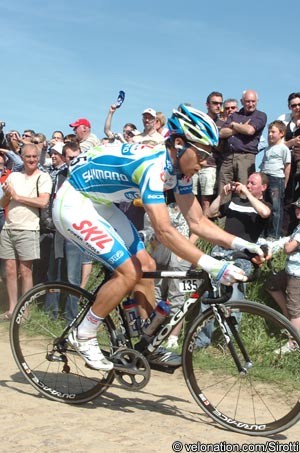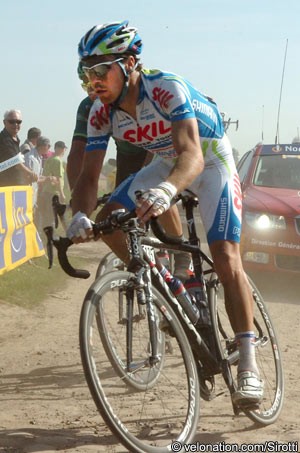Aussie continues upwards progression in Hell of the North
 For Mitchell Docker, Paris-Roubaix has been a race where he has shown steady improvement. The first time that the Skil Shimano rider rode the Classic was in 2009 when the dreaded letters ‘DNF’ appeared next to his name. He was back in 2010 to try again, and this time he finished in 47th place at 12 minutes 47 seconds.
For Mitchell Docker, Paris-Roubaix has been a race where he has shown steady improvement. The first time that the Skil Shimano rider rode the Classic was in 2009 when the dreaded letters ‘DNF’ appeared next to his name. He was back in 2010 to try again, and this time he finished in 47th place at 12 minutes 47 seconds.
In 2011 he chopped 12 minutes off the gap between himself and the winner, finishing an excellent 15th at just 47 seconds, sprinting for seventh after having been in the break of the day.
He showed his talent early on in becoming Australian national junior madison champion with Michael Ford in 2004; by 2006 he had joined the Drapac Porsche team, winning a stage in the prestigious Australian stage race the Tour of the Gippsland and the famous Bendigo madison with Zak Dempster.
The following season saw him take second spot – with Cameron Meyer – behind Jack Bobridge and Glenn O’Shea in the Australian madison championships. At the same time, his road racing also showed promise with podium finishes in places as diverse as Melle, Belgium and Imakane, Japan.
Still with Drapac, the podium places were even more exotic in 2008, with good showings in the Tour de Langkawi, in East Java, Belgium and France.
Docker’s move to Europe and a full pro contract came in 2009 with the Skil Shimano squad; a promising second in the semi-classic Halle-Ingooigem was the best result, and continued a yearly upwards progression.
Last season saw him show that he has what it takes to be successful on the European circuit with stage wins in the Delta Tour in Holland and Route du Sud in France, not to mention a strong 5th on GC in the Three Days of West Flanders.
His strong ride across The Hell of the North this year was preceded by an equally good ride in Gent Wevelgem where he finished sixth. If he can continue his upwards progression, some very big results are in store.
Docker took time out from recovering from his efforts over the pave to talk to VeloNation.
VeloNation: First off, that was a nice ride in Gent – Wevelgem, Mitchell; do you have any ‘if only’s?’
Mitchell Docker: I’ve looked at the replay many times and one thing I should have done was sprint all the way to the line, not sit up.
But I’d been full gas for the last 1,000 metres or so; I managed to get Boonen’s wheel but Steegmans started the sprint for him with 800 to go and the pace never eased from there to the line – it was incredible!
VN: Was this your first Paris-Roubaix?
MD: No, my third, the first one I was DNF but I was in the break last year and learned a lot about the race.
I was dropped in Arenberg last year but was really excited about being in the break; I never missed my turn and learned that it’s a race where you can do a lot if you’re away early.
This year, once I was in the break I decided that I’d get through Arenberg and then try to save a little for when the race caught us up – and when they did, I felt that I could follow.
It’s much less dangerous in the break because you can pick your lines.
VN: Are you conscious of packing away the food the night before?
MD: Yeah, and at breakfast, too. I’m not a big eater in a race, I don’t like it; so I try to eat as much as I can before the race – it’s a long effort, six hours.
After the race one of the guys on the bus was saying that he’d set a new record – 7,000 calories burned during the day.
VN: What’s the atmosphere like at the start?
MD: It’s much more stressful than at a stage race; this is my third time so I wasn’t too bad, but the first time I remember that I was really nervous – wondering how I would go and being around all those big riders.
 You’re not as conscious of the fans in Paris – Roubaix; in Flanders you’ll start a climb and think; ‘Jeez!’ there are so many crazy people there.
You’re not as conscious of the fans in Paris – Roubaix; in Flanders you’ll start a climb and think; ‘Jeez!’ there are so many crazy people there.
When I was a young cyclist it was the folklore of Paris-Roubaix which I grew up with; I learned more about the Ronde as my career progressed, but the first connection for me was with Paris – Roubaix.
Paris – Roubaix is a straight line and you just get in with it; but the Ronde with all those twists and turns takes a lot of learning.
VN: What was the Skil-Shimano game plan for the race?
MD: Pretty much as it turned out; get a man in the early break so as he’d be there for other riders from the team who came up.
VN: It must be a battle to get in that early break?
MD: It’s very hard, guys were telling me that five years ago it was always the little teams who were allowed to go; but now the big teams like Rabobank, QuickStep and Columbia want representation too because it takes the pressure off them.
The thing about trying to get into the early break is that it can cost you a lot of energy early on because you have to keep attacking to get with it.
VN: How was your race?
MD: It went pretty much to plan – before Arenberg I wasn’t that confident but I settled in and felt stronger as the race went on.
When the big guys came up to us I decided to follow and see how long I could hold on.
In the end I was 15th but sprinting for seventh place; I was first on the velodrome and kinda buggered up the sprint. I was at the front but didn’t want to drift back in case someone attacked as I was on the way back down the string. But next time I’ll do it differently and conserve more energy.
VN: What’s the ‘Docker Pave Philosophy?’
MD: Stay on the dirt; the fewer cobbles I ride, the better! I find myself drifting off them on to the dirt at the side; you can pick your line better and whilst they say you should ride them in the middle I find it better on the dirt.
You just feel better on the dirt and as the race goes on you get more tired and sore [if on the cobbles].
 VN: Isn’t there more risk of puncturing in the dirt?
VN: Isn’t there more risk of puncturing in the dirt?
MD: There is that risk but we were on 27mm Michelins and Koga ‘cross bikes so you’re riding equipment to suit how you’re riding.
VN: What about race food and drink?
MD: Like I said, I don’t like to eat during a race so I start early with the more normal foods; little sandwiches and pastries.
As the race goes on it’ll be gels, Coke and lots of energy drinks – if I don’t feel like gels I’ll drink twice as much because there’s sugar and energy in those sports drinks.
VN: Which was the hardest part of your day?
MD: When the big guys caught us with three sectors to go, when Cancellara and Hushovd were at the front before they went away, I was right on the limit.
It’s a crazy hard race but after it, you sit and think that you can’t wait to ride it again next year!
VN: If the radio ban goes ahead will you miss them in this race?
MD: For sure…whilst you have the sectors taped to your top tube it’s good to have your DS telling you what’s coming up and what’s happening in the race.
If you have a team mate coming up then you won’t pull as hard, for example – It means that you can think less and just concentrate on racing.
VN: Did you sit on that nice grass in the track centre after you finished?
MD: Yeah, I sat down and took it all in; it was a nice moment of reflection – my soigneur brought me a drink and even though I was buggered it was good to sit there and think that I’d made top twenty in Roubaix.
VN: In hindsight, would you have done anything differently?
MD: I can’t complain, I was in the break and it worked out to plan. There were attacks going from the group on the run in and I was thinking ‘maybe I should go with them,’ but that uses a lot of energy.
I’ve no regrets though, except maybe leading the sprint out; but even that – with the atmosphere in the velodrome – was special.
VN: How has your recovery been since Sunday?
MD: It’s taken me a couple of days but I’m feeling good today (Wednesday) – Monday and Tuesday I did an hour or so each day but spent a lot of time on the couch watching TV, eating and drinking a few beers.
VN: What’s next for you now?
MD: Amstel Gold, and then a week off!